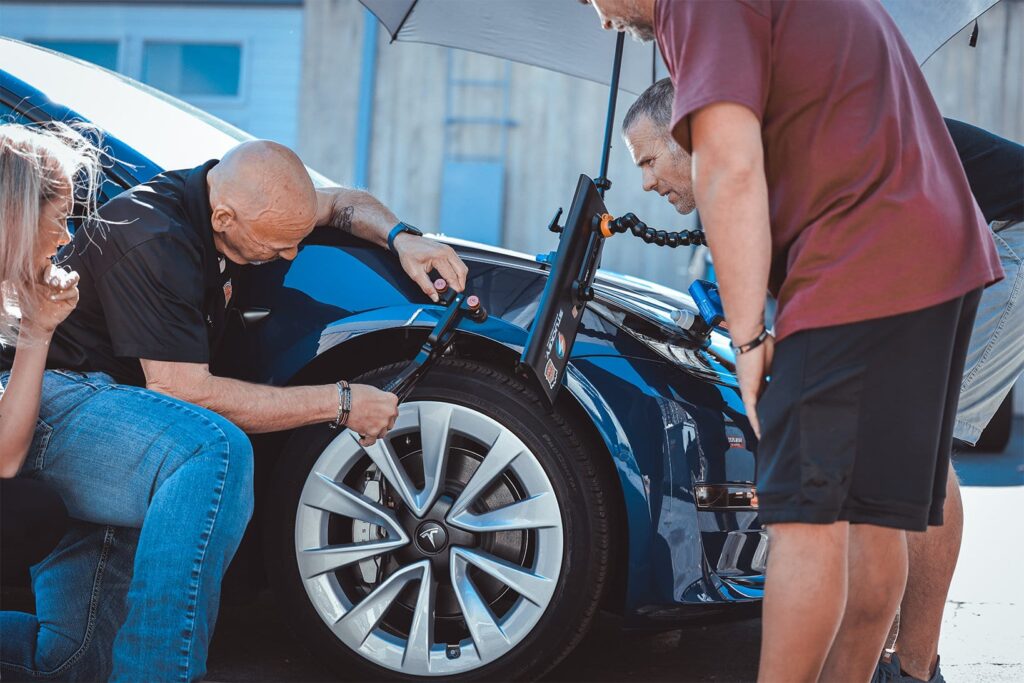Why Panel Access Is the Foundation of Successful Paintless Dent Repair
At Dent Repair School, one of the first core skills students learn is how to access the backside of panels safely, cleanly, and efficiently. While many beginners believe that the key to Paintless Dent Repair (PDR) is tool pressure or pushing technique, the real foundation of a smooth, invisible repair begins long before any pressure is applied. It begins with access. Access determines the quality of leverage, visibility, stability, and control. Proper access ensures that the tool makes contact with the correct point under the dent, and in the correct direction. Poor access forces bad pressure angles, inconsistent pushes, tool slipping, and unnecessary struggle.
Panel access is not simply finding a way behind the dent. It is understanding the construction of the vehicle itself. Automotive engineering varies among manufacturers, models, and vehicle designs. Some panels are single skin and easy to reach. Others are double-panel or reinforced with bracing, clips, adhesives, and intrusion beams. A professional PDR technician must learn to navigate these structures confidently and choose the shortest, strongest, and cleanest access path every time.
“The repair begins before the tool touches the metal. Access is the preparation that makes the repair possible.”
Understanding Vehicle Structure Before Repair
Every vehicle panel has internal geometry that supports shape and safety. To reach the dent, the technician must understand what lies behind the surface. Learning to visualize the unseen structure is a core skill developed through repetition, inspection, and guided instruction. Once the technician can anticipate bracing, support points, and internal limitations, tool selection and repair approach become clearer.
Access planning involves:
-
Locating the dent externally using reflection
-
Identifying the backside entry point that aligns best with pushing direction
-
Preparing the entry safely without damaging interior components
-
Stabilizing body position and tool grip before applying pressure
When these steps are executed correctly, the repair becomes efficient and controlled.
Tool Access and Pressure Direction Work Together
Even the best dent removal technique fails if the access angle is wrong. When access is direct, pressure can be applied slowly and gently, allowing for clean metal movement. When access is indirect or forced, pressure becomes uneven, leading to high spots, tool marks, or unfinished blending. This is why Dent Repair School emphasizes tool approach angle as much as tool movement.
Good access gives:
-
Strong tool leverage
-
Predictable pressure application
-
More control over metal flow
-
Cleaner finishing with less correction
Bad access requires force. Force results in error. Precision begins with access.
Types of Panel Access and When to Use Them
| Access Method | Best For | Advantages | Considerations |
|---|---|---|---|
| Factory Access Points | Doors, quarter panels, hoods | Direct clean entry | Must preserve grommets and seals |
| Trim Removal Access | Door edges, hatch panels, fenders | Wider working room | Requires interior carefulness |
| Glue Pulling (Surface Access) | Areas with blocked internal bracing | No disassembly | Requires blending skill after pull |
| Rod Access Through Bracing Gaps | Tight interior structures | Strong leverage | Requires tip control and patience |
The best technicians are those who select the correct method before beginning the repair.
Learning to Identify Access Quickly
Experienced technicians can often determine the best access route in seconds because they have internalized vehicle designs through repetition. However, this is a learned skill, not an instinctive one. At Dent Repair School, students train with multiple vehicle styles, model years, and panel constructions so they can recognize common patterns. Confidence in access does not come from trying harder — it comes from knowing how to evaluate structure efficiently.
With guided practice:
-
The technician stops guessing
-
The repair process becomes predictable
-
Repair time decreases naturally with confidence
-
Stress is replaced by calm problem-solving
This is how access mastery builds professional competence.
The Role of Lighting in Access
Even perfect access is ineffective without clear reflection reading. The light does not only show the dent — it shows the correction. Once access is established, the technician must rely fully on the reflection to guide pressure. Good access allows the light to become a reliable source of data. Without it, the technician is pushing blind.
Access and lighting must work together. One without the other cannot produce an invisible repair.
Key Takeaways
Panel access is the foundation of every successful PDR repair.
Understanding internal structure allows technicians to choose the most efficient access points.
Correct access improves leverage, pressure control, and finishing quality.
Confidence in access reduces repair time and improves consistency.
FAQs
Q: What if no access seems possible from behind the panel?
Glue pulling may be used when internal access is limited; it is part of strategic access planning.
Q: Is panel removal necessary for most repairs?
No. Many repairs use existing openings. Panel removal is reserved for specific cases where optimal access is needed.
Q: How long does it take to become comfortable with access decisions?
Most students begin recognizing patterns quickly once trained across different vehicle designs.
Conclusion
Panel access is the starting point of every paintless dent repair. It does not receive the same attention as tool technique, but it is the condition that allows technique to work. When a technician understands how to approach a panel, where to enter, and how to support the tool path, the repair becomes controlled, predictable, and clean. At Dent Repair School, students develop the structural awareness and confidence needed to make smart access decisions — the decisions that lead to professional-level, invisible repairs done the right way.



